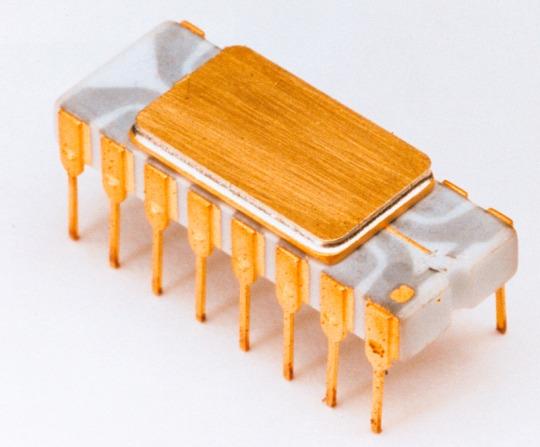The slender smartphone you’re carrying in your pocket has more computing power than NASA needed to put a man on the moon. If you’re looking for someone to thank for that technological miracle, you can start with Dr. Gordon Moore.

Intel’s original microprocessor, the 4004 (Intel).
This Sunday marks the 50th anniversary of “Moore’s Law,” a dictum that has guided the technological revolution from the earliest days of silicon through the iPhone 6.
On April 19, 1965, Gordon Moore, then director of research and development at Fairchild Semiconductor, published an article in an industry trade journal with the informal title “Cramming more components onto integrated circuits.”

In the Electronics article, Moore noted the exponential growth in the development of silicon and made a bold prediction: The density of electronic circuits would double every year, while the cost of producing them would drop at a similar rate. In 10 years, he surmised, we would see as many as 65,000 transistors crammed onto a single chip.
Here’s what Moore wrote in 1965:
“Integrated circuits will lead to such wonders as home computers – or at least terminals connected to a central computer – automatic controls for automobiles, and personal portable communications equipment. The electronic wristwatch needs only a display to be feasible today.”
Moore’s vision was more spot on than anyone could have imagined.
Moore is more
In the year Moore’s article appeared, Syvania manufactured the first read-only memory (ROM) chips. They held a whopping 256 bits of data (enough to hold 32 characters, or about ¼th of a tweet) and were programmed one bit at a time by a technician who carved the connections into the chip by hand.
Three years later, Moore and Robert Noyce left Fairchild to form a new company. Then called it Intel. In 1971, Intel released its first general-purpose microprocessor: the 4004. It was the size of a thumbnail and held a whopping 2,300 transistors. Today’s Intel Broadwell-U processor is roughly the same size yet holds nearly 2 billion transistors. The chip also costs 1/60,000th as much to produce.
To honor the 50th anniversary of Dr. Moore’s observation, Intel released a series of brain-melting comparisons to what would have happened to other industries if they had followed the same growth trajectory.


No comments:
Post a Comment